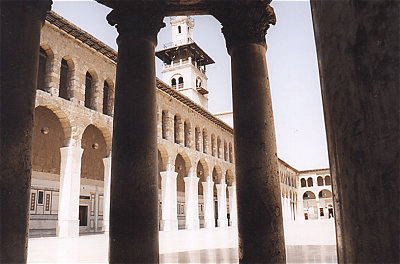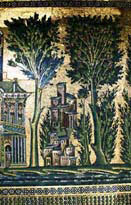First imperial mosque built by Caliph al-Walid I (705-1715), the son of Abdul-Malik. It is one of the largest and oldest mosques in the world, and one of the few to have three minarets: al-Arus minaret, minaret of Jesus and minaret of Qaytbay.
It is on the east end of Souk al-Hamidiyeh in Damascus. The site has been built thousands of years ago. In 3000 BC there was an Aramean temple to the god Hadad, the ancient Syrian god of rain and fertility. In the 1st century AD a Temple to Jupiter stood on this location. It was restored 193-211 under the Roman emperor Septimus Severus, Emperor Theodosius made it the Church of St. John the Baptist in 379.
It remained a church for a long time after the Arab conquests; in 636 the Muslims built a mud brick structure against the south wall for prayer. The Umayyad Caliph al-Walid built the Great Mosque in 706-515 and compensated the Christians with four permanent church sites elsewhere within the old city.
In the mosque, a shrine is believed to hold the head of John the Baptist.
It is said that 12,000 men worked to build the mosque. The plan of the mosque is rectangular, 175m x 97m. Its northern part is an open courtyard. In the courtyard are the Zein al-Abidine Dome built on eight Corinthian columns, the ablutions fountain covered with a dome on columns, and the beautifully decorated Khazne Dome on eight Corinthian columns. The courtyard is surrounded by a riwaq of columns and piers. The exterior wall has three gates that lead to the city on the northern, eastern and western sides. The three minarets were built by al-Walid and were restored in subsequent years. Al-Arus, a square tower, is in the center of the northern wall. Its lower part is original; the upper part was rebuilt in 1174. The minaret of Jesus is at the east. It has a Mamluk lower part and an Ottoman top. The beautiful minaret of Qaytbay with stone carvings and inscriptions was named after the Mamluk sultan who rebuilt it in the 15th C. The latter two are built on the foundations of Roman towers. It is interesting to note that the proportions of the elements of mosque are divisible by 4: there are four halls named after each of the four Rightly Guided Caliphs, and are used for meetings and lectures and to store books. The qibla wall is 136 m wide. There are four mihrabs, forty windows, four gates, 52 columns each eight meters tall and weighing eight tons.
The chandeliers in the main hall are from various periods, some form the Mamluk time, others from the Ottoman period, and most are made from hammered damascene brass. The carpets are signed by their weavers.
At the southern side of the mosque is the women’s sanctuary with craved wooden screens to the interior of the courtyard. It is formed by three riwaqs supported on two rows of columns. Hafsa bin Omar and Khawla bin al Azwar taught religion in the early centuries of Islam in the riwaqs. There is also a maqsura which was used by the sultan.
Mosaics cover the top parts of the walls on both the interior and exterior sides in the haram, riwaqs, the arches and undersides of the vaults. The stone fragments were mixed with colored glass, gold and silver leaf covered glass, and marble between to create a unique reflective material that sparkles its geometric and floral patterns. They depict landscape scenes of well-watered Damascus, like the Barada River flowing alongside the great Umayyad palaces on its banks and orchards of fruit bearing trees. This makes the Umayyad mosque a treasure of world class mosaics.




